First! I recently opened applications for my February Arizona Beginners Backpacking Trips- go from zero outdoors experience to knowing enough to plan your own backpacking trips! Plus eat KK’s incredible cooking. I imagine that these will sell out. Deets and the application are here, plus read reviews from past participants.
Also! Do you want to become confident with using caltopo for cross country navigation? And wander about in canyons in the beautiful southern Utah desert? There are still a few spots in my fall Utah trips, which are honestly a peak experience. Deets and the application are here.
Part one of this series is here, part three is here, part four is here.
Day 3
June 16
I sleep for ten hours. Ten freaking hours! When, in the past twenty years, have I slept for ten hours in a bed in a house? Not one single time. But on the ground with a slowly deflating sleeping pad, in a stuffy shelter that flaps in the wind, the sun bright in the sky all night long? No problem!
Today we find more waterfalls, more caribou trails, and a gravel bar full of fossils- shells and coral from a long-ago seafloor. We take a break here and the Sarahs spend a lot of time looking for the very best fossils that are worth carrying for the next week, even though they’re literally rocks so are quite heavy. I choose a small coral fossil to take home to my boyfriend. (Plot twist- when I give it to him after returning home he tells me that it isn’t actually coral, but a cluster of worms! Ancient coral was colonies of worms!)
We walk on lots of snow over drainages with creeks today, which scares me- what if I plunge through the snow into darkness, am trapped in the icy water below and drown? I ask SH about this and she says it never happens, because the snow over the creek is actually the thickest part, because the running water keeps it colder. Also, the creeks are only like four inches deep. I start to feel better about the snow walking- it’s actually quite good walking. We do posthole sometimes, but mostly the snow is firm. And it’s funny to be walking in snow in the hot, beating sun, worrying about getting sunburnt from below. It reminds me of the high sierra on the PCT.
We talk about perimenopause as we meander, as one does, and then SH reveals a special skill- finding birds’ nests. What looks like a random tuft of grass turns out to hold a round nest of ugly, hungry baby birds that open their mouths to us, expecting worms.
“I saw the bird flush,” says SH, “so I went to that spot and here was the nest.” There are no trees here so birds make their nests right on the ground, which seems wild. We don’t know what kind of bird it was but both Sarahs have the Merlin app so as soon as more birds appear, they’ll be ready.
We change our route at every junction, depending on our whims. We walk small creeks to their headwaters at the most incredible passes, and then down the little baby creek on the other side, watching it grow. On our steepest pass we’re side-hilling on caribou trails when we hit a huge unexpected snowpatch, where it would actually be pretty sketchy if we fell- but the snow is soft, not icy, and we make it across without problems.
In the afternoon we enter a brushy valley where the flowers are starting to pop off and SH shouts “bears!” and points at some specks on the far hillside. There are no black bears here, just grizzlies, and in the distance are three of them- a mom and two cubs. They’re too far to get a good pic of with my phone but luckily SJ brought five lbs of camera equipment, including a super long lens that makes her look like a national geographic photographer. The bears sway curiously in our direction as she captures some sick shots and then they catch our scent and run away, up the steep scree slope and across a snowpatch. We marvel at how blonde they are, joking that it makes sense to be light-colored here since it’s always hot and sunny, to reflect the heat. “Bears!” says SH again and we see more specks, another mom and two cubs, also blonde. They’re poking around in the creek at the bottom of the valley, they haven’t noticed us yet.
“Let’s get out of this valley,” I say, hoofing it through the dwarf birch towards the pass.
In the bright, hot evening we arrive back at the broad, flat tundra that was our dropoff point and retrieve our stashed ursacks- the snowbank we buried them in melted away and they’re sitting in the branches of a willow, as if floating. This landing spot is some sort of alluvial fan? Covered in the scantest bit of topsoil and the tiniest tundra plants. I walk what feels like a half mile across it to find my other ursack, trekking poles folded neatly inside, where our pilot left it with a pile of gear for another group. Reunited with my chips, hurrah! I am relieved to plop down on the tundra overlooking the creek and heat water for my bean dinner and then pour my olive oil in. So far the olive oil challenge is going great. I feel good, and my poops aren’t weird. I could even be consuming more every day, I feel like. I wish I’d brought 50 oz instead of 33.
Day 4
June 17
SJ is worried about her cheese. She brought three pounds of cheese, an entire two pound tillamook loaf of colby jack and another one-pound loaf of chedder, but wasn’t expecting this heat- when backpacking in Alaska, you don’t expect it to be hot 24/7. Some of her cheese is starting to mold and she scrapes the mold off with her spork, frowning. “Maybe I should bury my cheese in a snowbank at night?” she says.
We’re headed north today on our traverse to the pickup spot, and our packs are heavy with eight days of food. On the ninth day, day 12 of our trip, we’ll get picked up, and I’d meant to bring food for that day, but I kind of didn’t? I think about what I can set aside- a bar, a few other small things. We’re not sure when we’ll get picked up on day 12, and if the weather’s too bad for our pilot to fly we won’t get picked up that day at all. I ask the others if they have stories of not getting picked up by bush pilots, and the worst one SH can think of is from the book The Sun is a Compass, where this couple does the most insane paddling/skiing/walking traverse from Bellingham to Alaska and then across the Brooks Range. They reached one of their pickup spots completely out of food, and it was five days before the weather was clear enough for the pilot to land. Not only that, but the pilot didn’t realize the seriousness of their situation and he picked up some guests from a remote lodge first, before doing the flight to pick them up!
At lunch we are desperate for some shade so SJ pitches just the outside part of her x-mid and we lay under it after splashing in the creek, dozing while the sun broils us through the silnylon. Afterwards I am impossibly sleepy for the rest of the day, and in a terrible mood. We end up hiking late to reach a river that will be our one difficult crossing of the entire trip, in order to get our eyeballs on it.
“We’re gonna die crossing this river,” I say, looking at the roiling chocolate water. “And the camping here sucks.”
The others ignore me and merrily pitch their shelters on the gravel bar, which does not in fact suck, and ends up being one of our best campsites- sheltered from the wind, which can be hard to escape out here, and even a bit shaded by the high bank- shade is priceless, and the closest thing we have to darkness. The white noise of the river is nice too, and I want it to lull me but instead I lay awake, feeling miserable. Do you ever just get so tired you can’t sleep? Finally I drift off, around midnight.
Day 5
June 18
I sleep through my alarm, which is kind of a blessing honestly. I needed the rest! This morning the river is lower, too, and less roiling. On the map it shows braids upstream, and after weaving through the brush for an hour we find them, and the crossing is very chill. It’s amazing how chill an intimidating river can be if you just find a spot where it has braids. For most of our trips we’re staying close to the continental divide, so all our other crossings will be a non-issue. (Brooks Range hot tip- if you don’t want to packraft, stay close to the continental divide, where you’re close to the headwaters of everything so the creeks are at their smallest.)
We’re aiming for a ridgewalk today- it’ll be a lot of work to get there but once up it’ll be glorious. Yesterday was kinda brushy- we dropped down to 1200 feet and learned our lesson- even though the ridges are more climbing, the walking up there is well worth the effort. We decide to do our best to stay above the brush for the rest of our trip.
I think we all feel relieved once we’re up on the ridge- this is why we’re here, for the good walking in the alpine, the land stretching below us for miles in every direction. Up high we find some tufts of blonde fur, and then a skull- a baby bear skull? It must’ve been a little blonde bear. How did it die? Did it get eaten by another bear? Nature is so metal. Everything out here is eating everything else, keeping each other in check so nothing grows so large it destroys its land base and dies off. If only we as humans had more natural predators, to save us from ourselves…
One thing that cracks me up about this trip is how cold the water is compared to the air. Whenever the water in our bottles warms up we just dump it out and replace it with new, icy water from the creek. Never have I ever overheated like this in a place with such an abundance of freezing-ass water.
We have lunch on the very top of the ridge and watch a huge thunderstorm roll in as we eat. Uh-oh. The thunderstorm is coming from the direction of Red Dog Mine, which is one of the largest zinc and lead mines in the world and is a few days’ walk away, as the crow flies. I joke that it’s always thundering at Red Dog Mine, that if we could see it in the distance there’d be a huge Eye of Sauron floating over it, like in Lord of the Rings. Red Dog Mine is only accessible by air, and is essential to the economy of Kotzebue, which acts as a sort of support hub.
“Without Red Dog Mine, Kotzebue would collapse,” said our pilot, as we crossed the wide open tundra on our flight here.
A few years ago I went to a talk in Anchorage, put on by the department of fish and game, about the current state of Alaska’s caribou herds, several of which are in decline. There were a series of speakers, and at one point a spokesperson for Red Dog Mine stepped up to the podium.
“Pollution from Red Dog Mine does not affect the Western Arctic caribou herd,” she said, somewhat mechanically. “Pollution from Red Dog Mine does not affect the rivers, and as a result the salmon runs, in Northwest Alaska.”
“Ok?” I thought, after she finished speaking. I knew nothing about Red Dog Mine and hadn’t even considered how it was impacting the environment, but now I was convinced that they were the single biggest thing affecting both the caribou and the salmon in that area.
Zinc is crucial for renewable energy. Worldwide demand for zinc is growing, and will continue to grow. It would be hypocritical of me to just eschew mining across the board- I use a smartphone, for godsakes. I don’t want to be a nimby, and as tempting as it is to idealize super rural people and imagine them living with the land completely outside of capitalism, they need jobs to survive just like the rest of us. And isn’t it better to have this mine in Alaska, where there are labor regulations, than somewhere where there aren’t? Still, it does feel like the mine is a huge blob of pure evil lurking just on the other side of these magical, untouched mountains, and I find myself wishing that there was some middle ground between mining being the literal devil and not having mines at all.
“Maybe we should get off this ridge?” SJ says, as the huge black clouds creep closer. Lightning strikes, and we all count. Thirty miles away. We pack up our snacks and hurry along the ridge, dropping off as soon as we can find a good spot and side-hilling down to the drainage below. The storm hits. Warm, heavy rain. More lightning. Seven miles away. Five. We decide to descend the drainage back to the brushlands and go around this ridge. Hopefully by then the rain will have stopped, and we can climb back up.
The rain does stop. It never even gets cold. Warm, intense thunderstorms that only last a few hours, and then blue skies again? Where even am I? I packed fleece gloves with waterproof mitts, a synthetic puffy, a rainjacket and rain pants- all with the idea that the temp would drop if the rain came. Well. I’m not complaining.
As soon as the rain stops there are, all of a sudden, mosquitoes. Not a ton but they definitely exist. And birds! There’s birdsong! The Sarahs have their phones out, trying to catch the calls with Merlin. We climb again, up another drainage towards another tundra pass. We find a good upholstered spot above the creek. The cursed sun is back but it’s softer now, it feels muted. I lay down on the tundra at our campsite, the moss soft and springy from the rain, and feel that I could sleep just like this, no sleeping bag, no shelter. Let myself be slowly subsumed by the lichen.




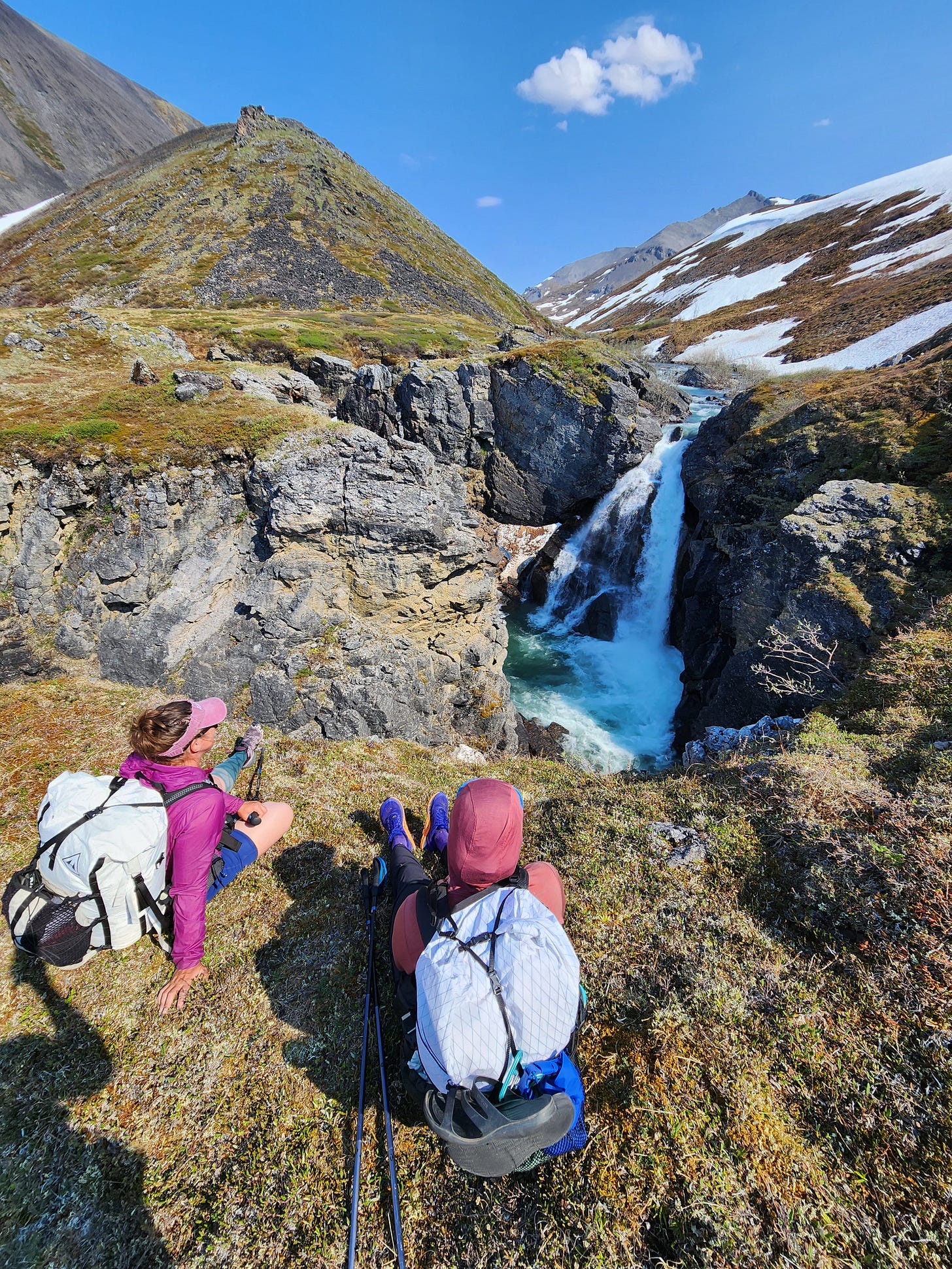
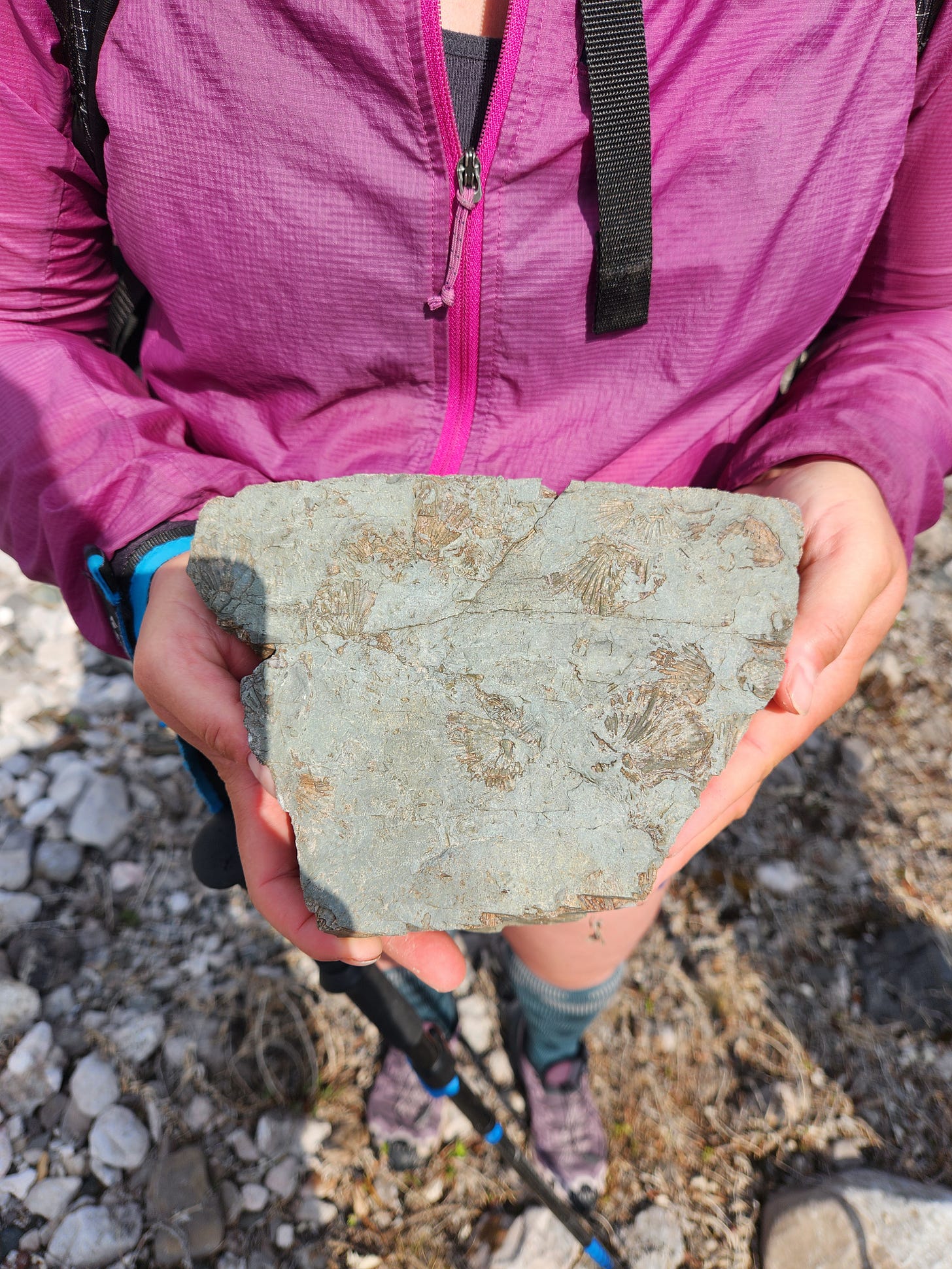
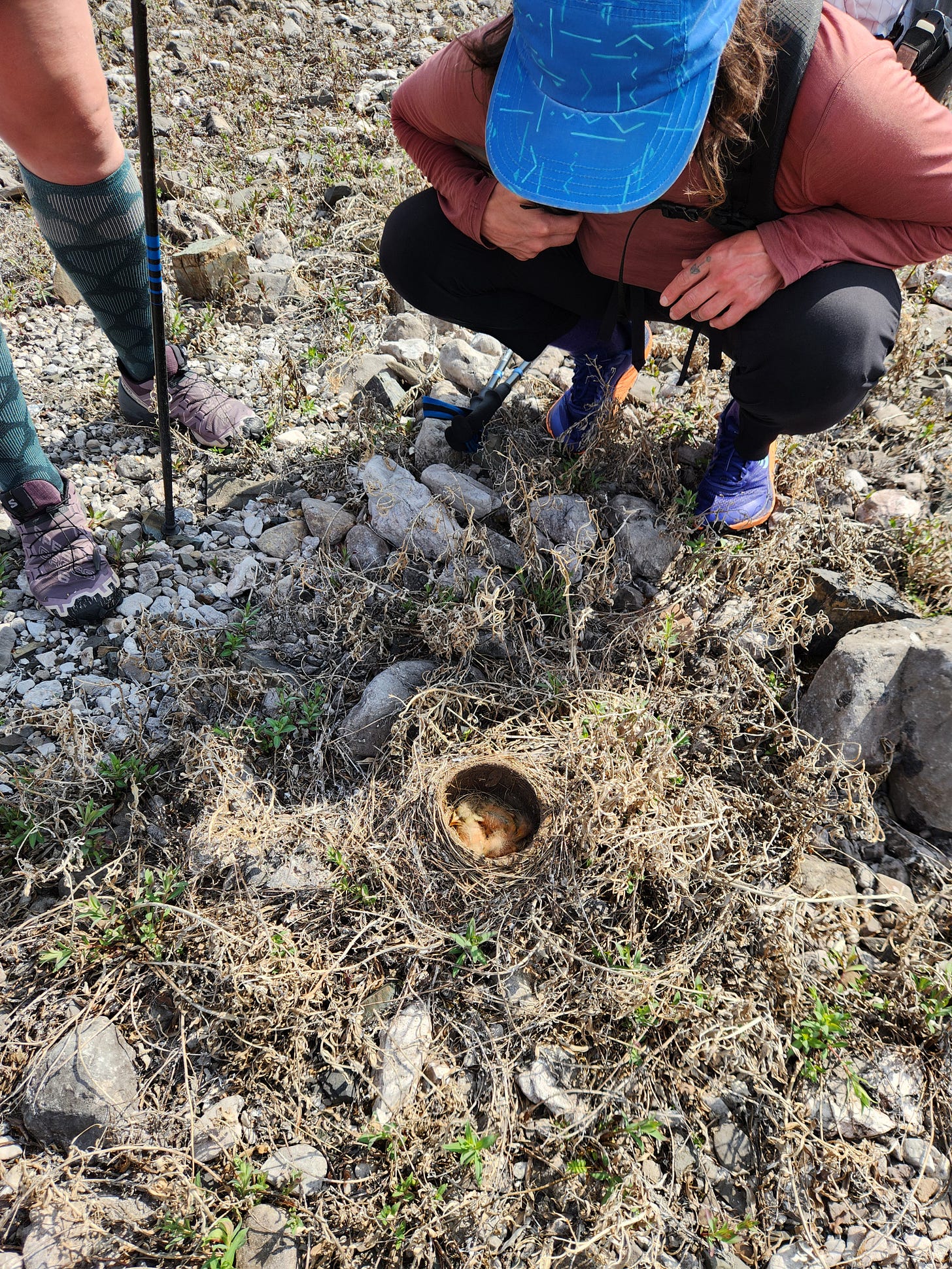
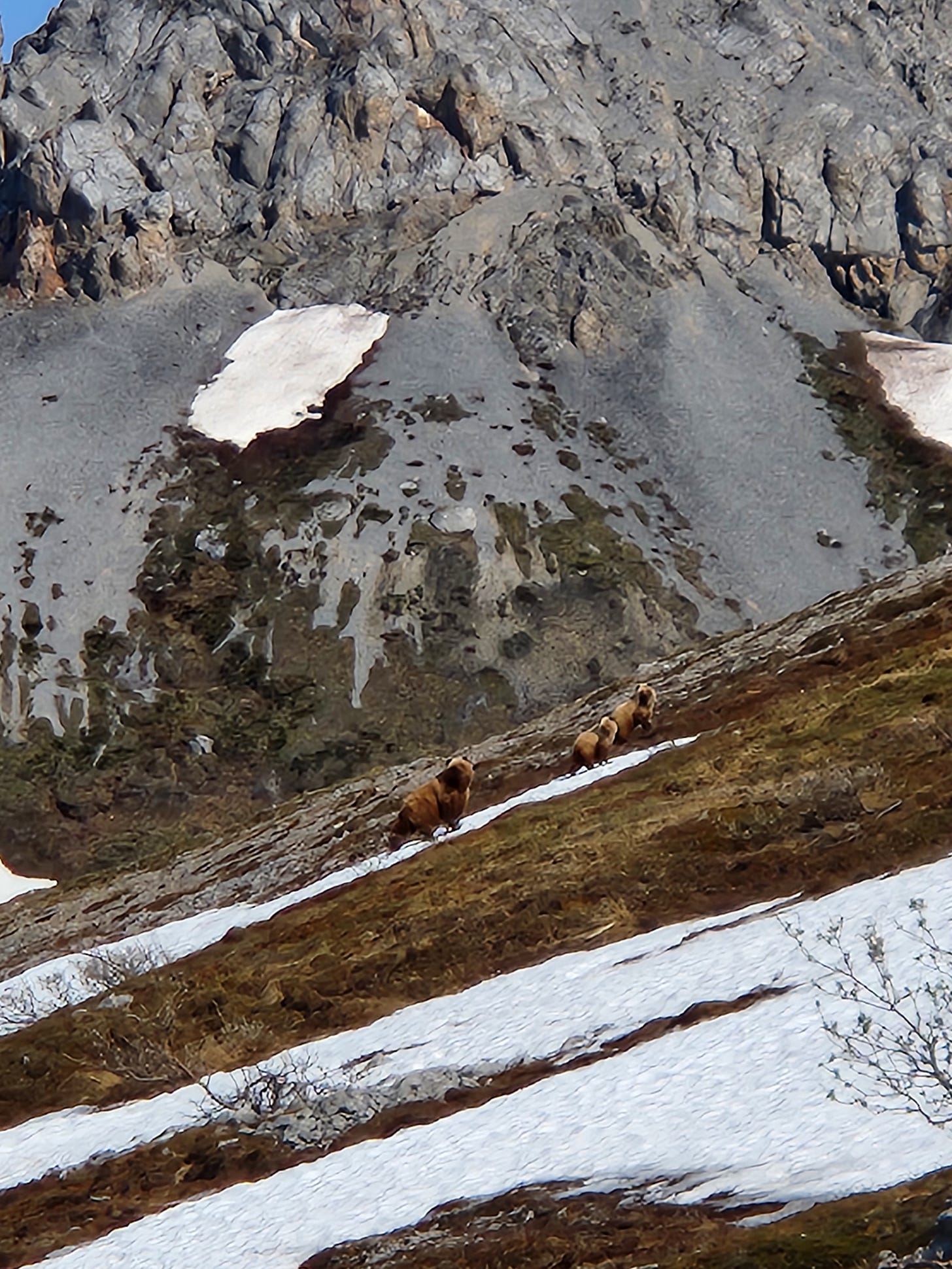
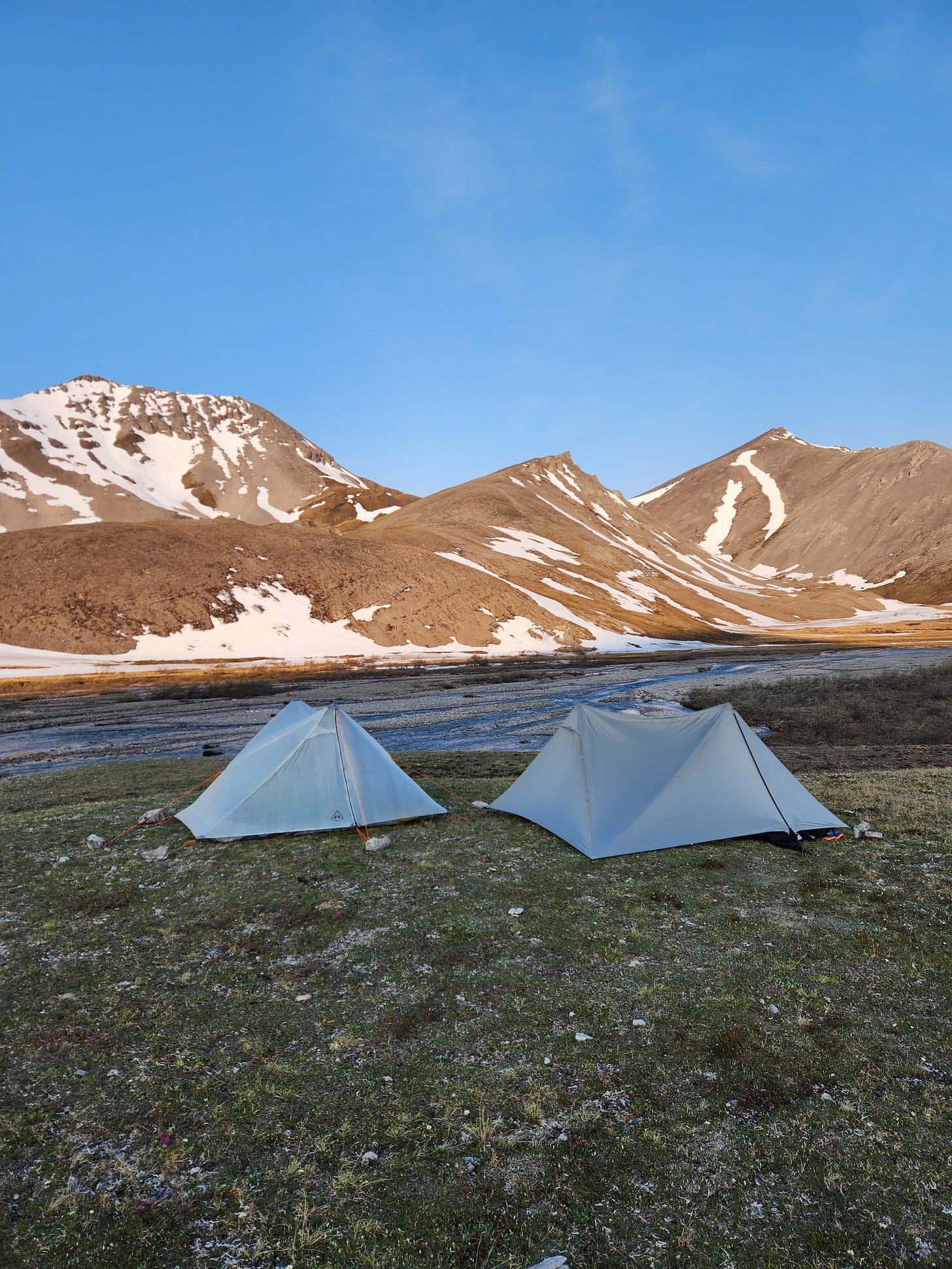

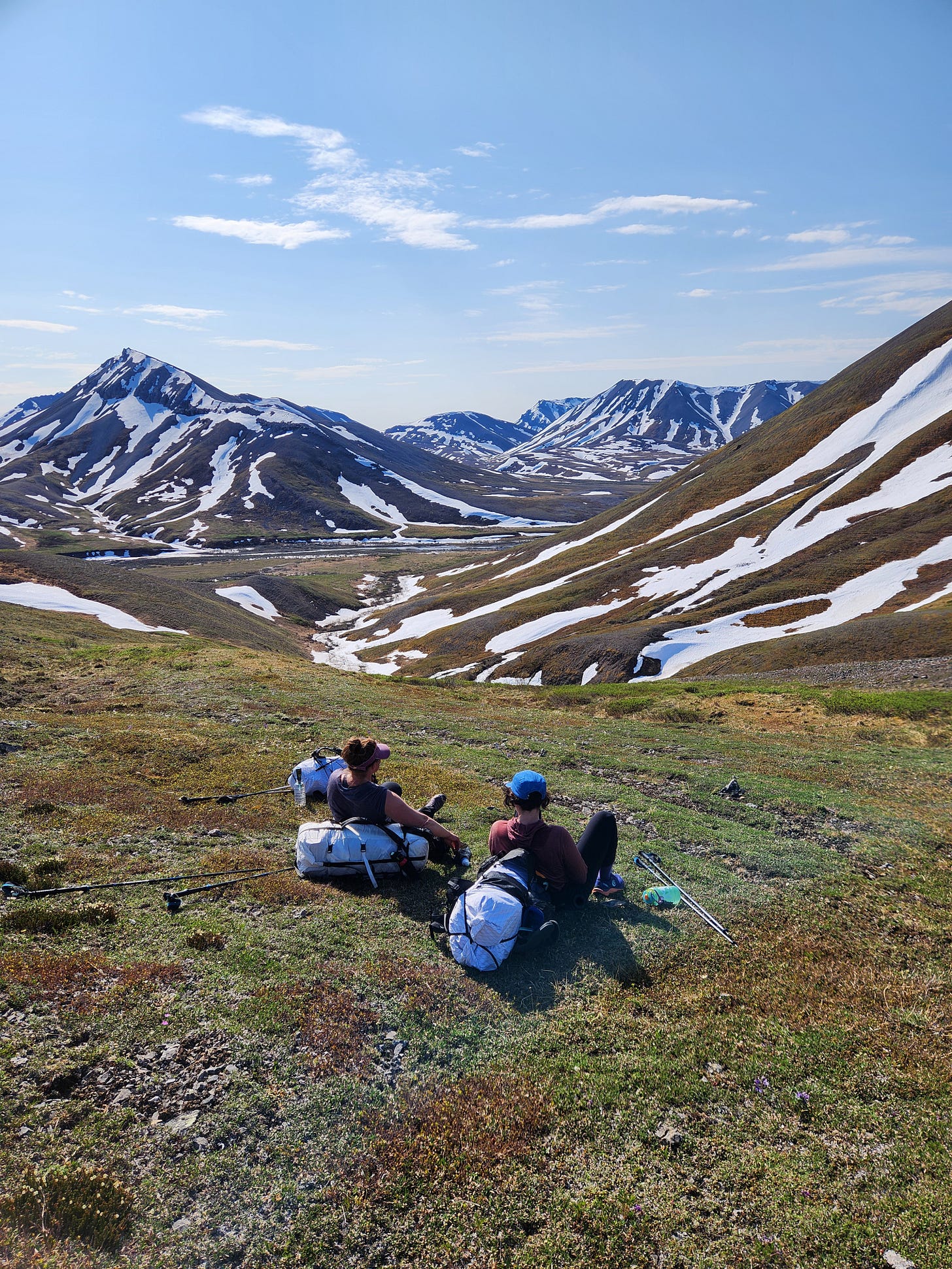
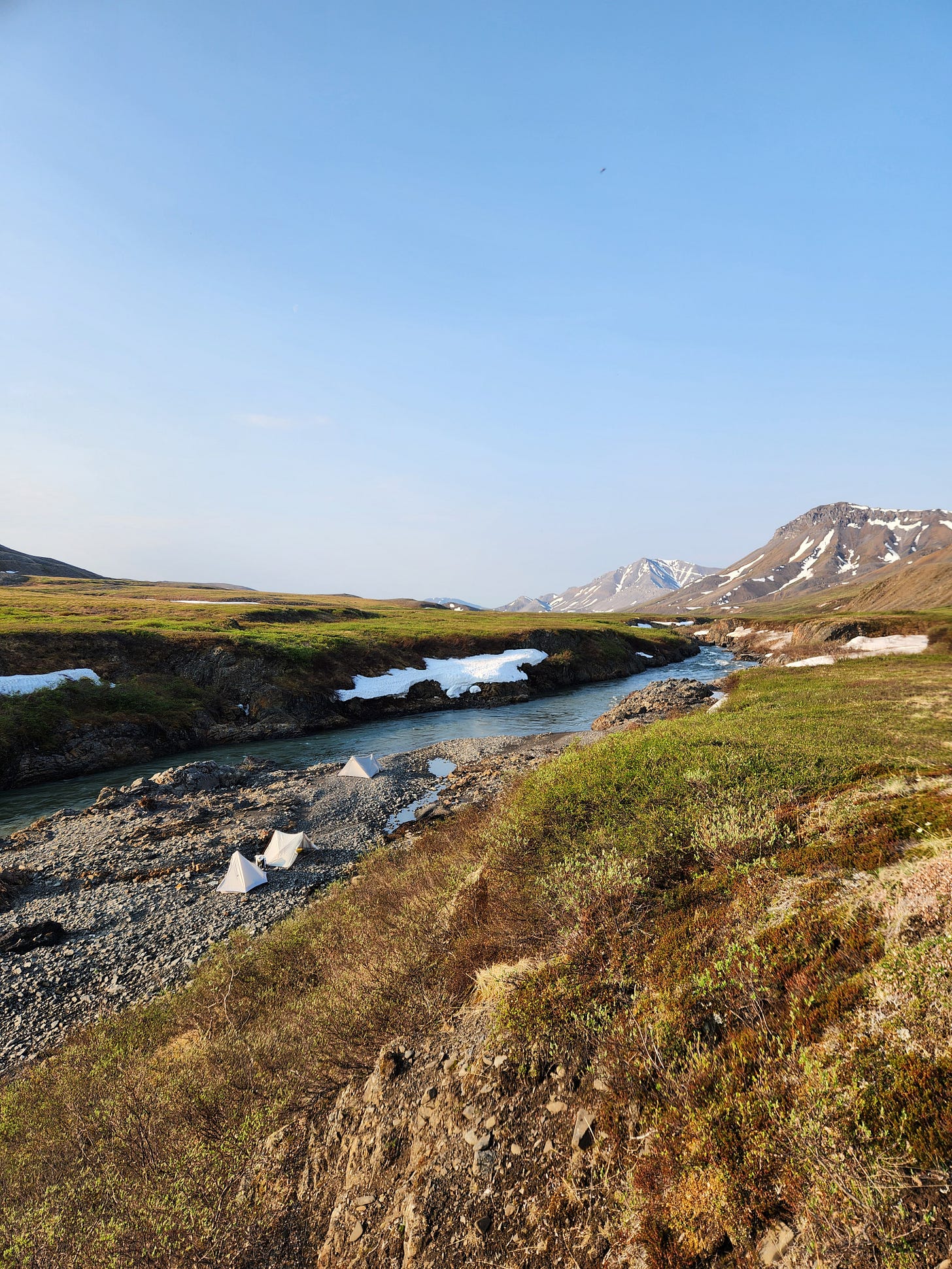
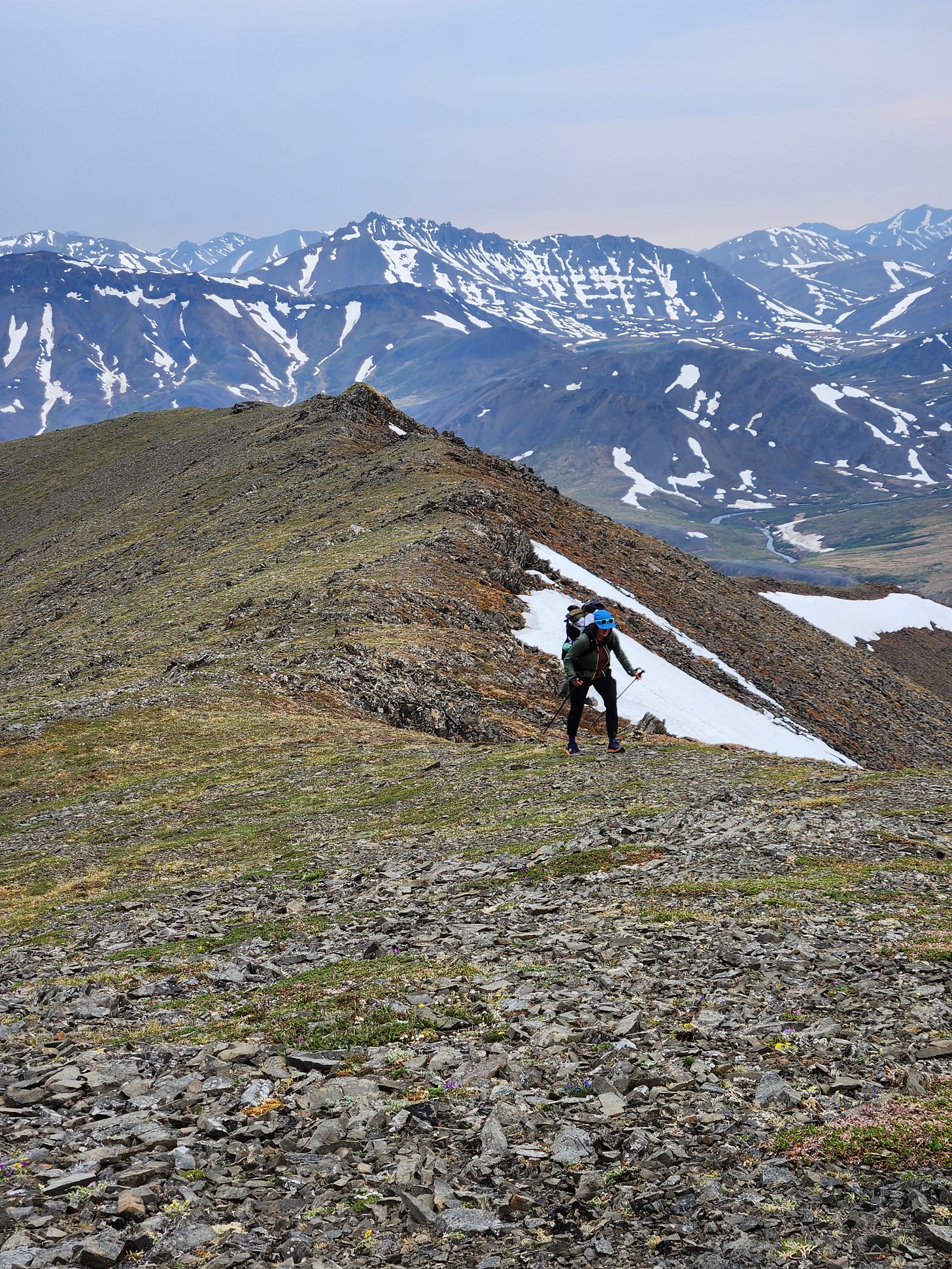
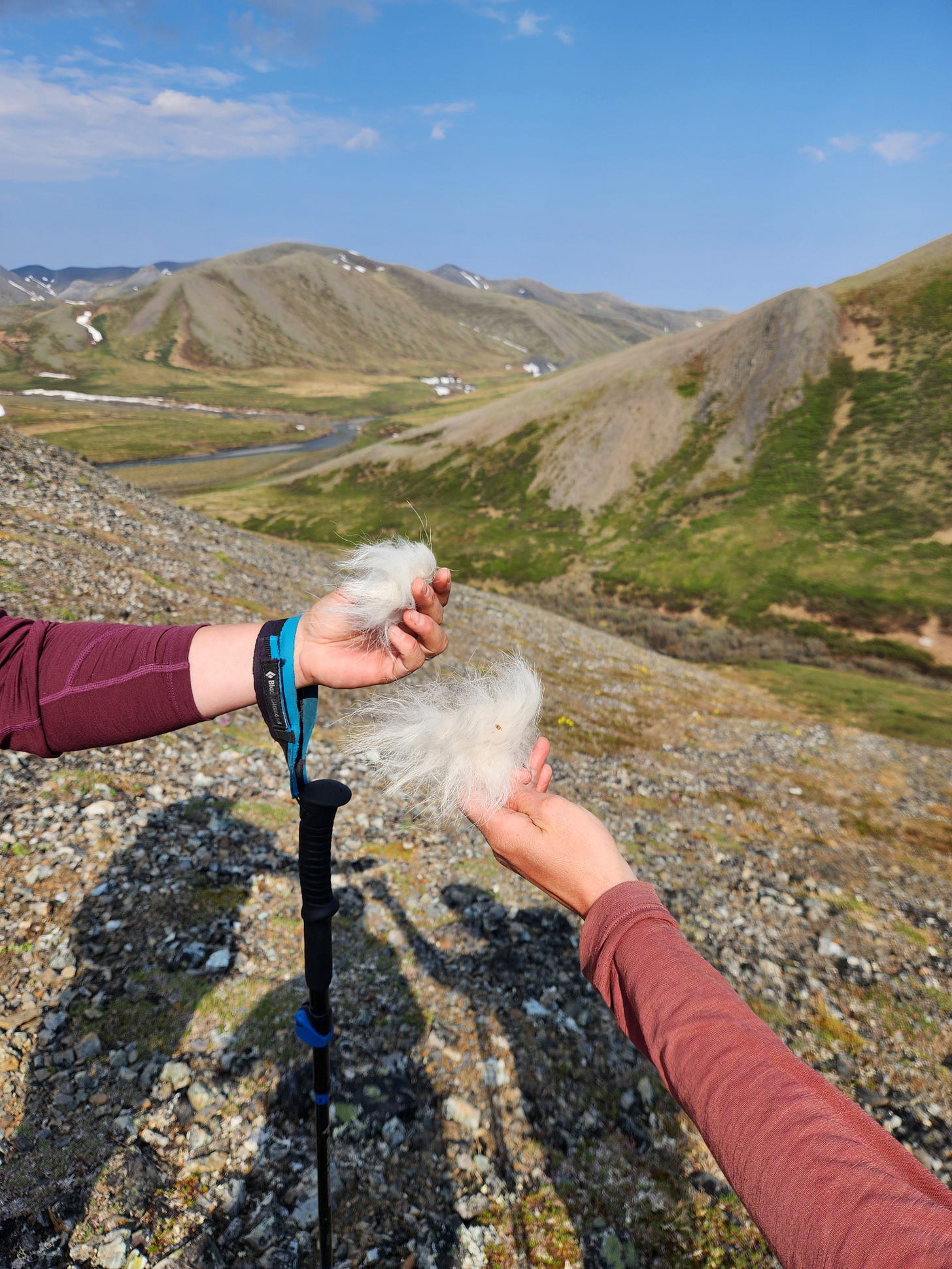
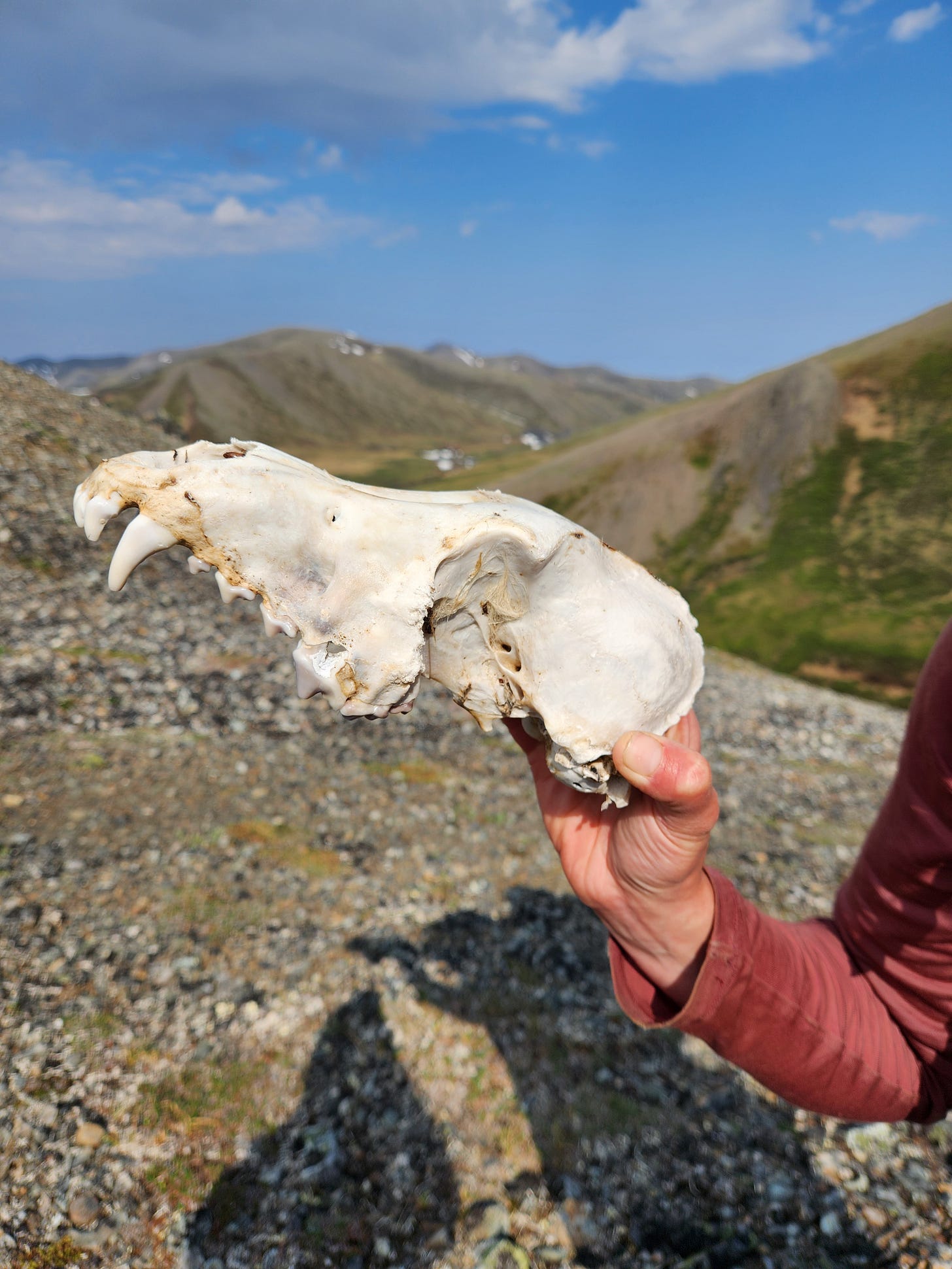
I love how real you are (always). Thanks for sharing your latest-adventure-yammerings with us, Carrot! And yes, I can relate to the too tired to get to sleep thing. Eesh.